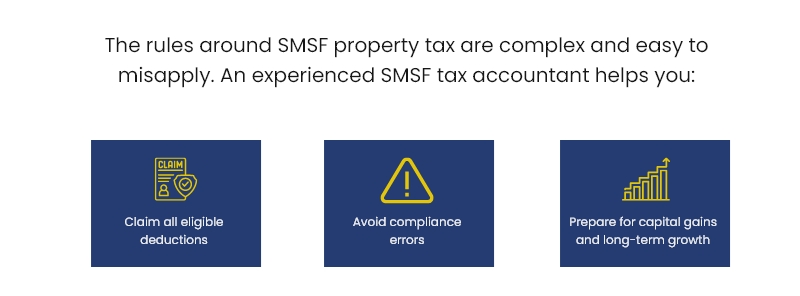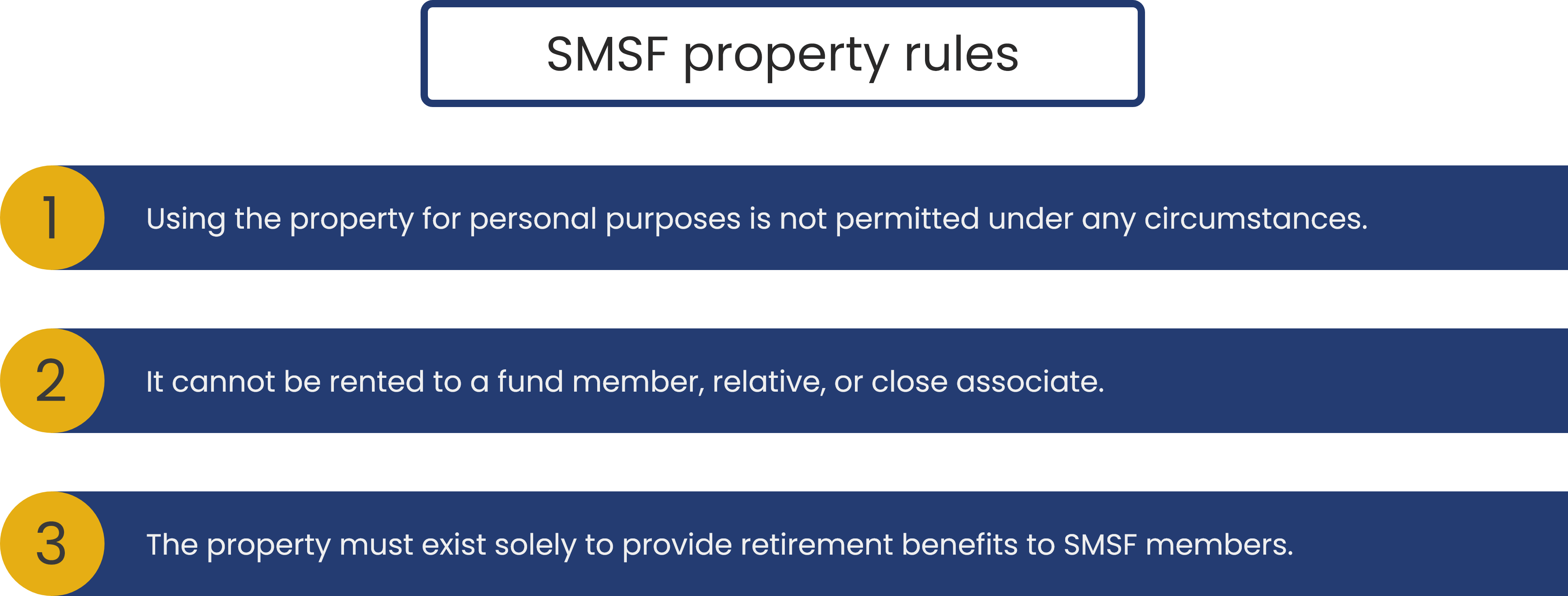Benfits and risks of buying property through your SMSF
Introduction
According to the ATO’s latest quarterly statistical report, between June 2021 and June 2024, self-managed super funds (SMSFs) increased their residential property holdings by 26.4%, reaching $55.2 billion.
Non-residential property also saw a 25% increase, totalling $102 billion. These figures reflect a significant shift in how SMSFs are being used to acquire direct property assets as part of broader retirement planning strategies.
Property remains an attractive option for many SMSF members seeking long-term growth and income. However, acquiring real estate through an SMSF is not without restrictions. Regulatory requirements, structural limitations, and financial risks all need to be considered before pursuing this investment path.
This article explains the key advantages and possible challenges of purchasing property through an SMSF to help you determine whether this approach supports your retirement objectives.
Key takeaways
- More Australians are using their SMSF to invest in residential and commercial property.
- Any property owned by your SMSF must be used only to help fund your retirement.
- SMSF rental income is taxed at 15 percent and may become tax-free in retirement.
- SMSFs can borrow to buy property using a special loan structure called an LRBA.
- The ATO has strict rules on how SMSFs can buy, manage, and report on property.
- Getting expert advice is important to make sure your SMSF property purchase follows all the rules.
What is an SMSF?
A self-managed superannuation fund (SMSF) is a type of superannuation structure that allows members to manage their own retirement savings, including investing in property. However, strict conditions apply when purchasing property through an SMSF.
In order to buy property through an SMSF, you must follow these requirements:
- The property must comply with the sole purpose test, meaning it should be held only to provide retirement benefits to fund members.
- It cannot be lived in by any fund member or their relatives.
- It cannot be rented to a member or related party unless it qualifies as business real property and is leased on commercial terms.
- It must be purchased from an unrelated party unless the property is either business real property or a listed security.
- The purchase price must reflect the asset’s market value, supported by proper documentation or an independent valuation.
- The investment must align with the SMSF’s documented investment strategy, considering risk, return, and retirement objectives.
- The transaction must not cause the value of in-house assets to exceed five percent of the fund’s total assets.
- If borrowed funds are used, the purchase must be made through a limited recourse borrowing arrangement with a separate holding trust.
These requirements ensure that property investments through your SMSF are legally compliant and used to support long-term retirement goals.
Looking for an SMSF loan?
Connect with our SMSF loan specialist to explore borrowing options tailored to your fund’s investment goals.
5 SMSF property investment pros every investor should know
Property investment through an SMSF is a strategy many Australians are turning to. Here are five major advantages driving that decision:
Tax advantages
If you invest in property through a self-managed super fund (SMSF), the rental income is taxed at a concessional rate of 15 percent, provided the fund follows superannuation rules. If the property is held for more than twelve months before being sold, your SMSF may be eligible for a one-third capital gains tax discount, reducing the effective rate to 10 percent.
When the property supports a retirement-phase pension, both rental income and capital gains can become fully tax-free under the exempt current pension income rules. This makes property a tax-effective option for building retirement wealth.
You can also claim deductions for property-related expenses such as maintenance, insurance, council rates, and interest on limited recourse borrowing arrangements. These deductions reduce your fund’s taxable income and support better returns.
It is essential that all transactions are made at market value. If income or expenses are not commercially reasonable, the income may be treated as non-arm’s-length and taxed at 45 percent. Ensuring compliance helps preserve the tax benefits of your investment strategy.

Asset protection
Assets held within your self-managed super fund (SMSF) are legally separate from your personal ownership. This separation offers protection from claims made against you as an individual, including situations such as bankruptcy or legal disputes.
Creditors typically cannot access property or investments held in your SMSF, which helps preserve your retirement savings regardless of your personal financial position. This level of protection can be especially important if you are a business owner or a professional exposed to higher financial risks.
The superannuation system is designed to keep these assets secure and focused solely on retirement outcomes. As long as your SMSF remains compliant with the rules, this protection stays in place automatically, without the need for any special legal arrangements.
Leverage through limited recourse borrowing arrangements
A self-managed super fund (SMSF) can borrow money to invest in property using a structure called a limited recourse borrowing arrangement (LRBA). This allows the SMSF to buy a property even if it doesn’t have the full amount upfront.
The property is purchased through a separate holding trust, and while the SMSF is not the legal owner at first, it receives all rental income and any capital growth. The loan is repaid over time using rental income and contributions to the fund.
For example, If your SMSF has $200,000 and you want to buy a commercial property worth $500,000, the fund can borrow the remaining $300,000 using an LRBA. The property is held in a trust, and your SMSF benefits from the returns.
Once the LRBA loan is fully repaid, the SMSF trustee can initiate the legal transfer of the property’s title from the bare trustee to the fund. This transfer is not automatic and requires proper documentation, but in most Australian states, it generally attracts only nominal or no stamp duty if the LRBA structure was compliant from the outset.
If the loan defaults, the lender’s rights are limited to the property itself. The rest of the SMSF’s assets remain protected, helping to manage risk within the fund.
Process of limited resource borrowing arrangement

Diversification of investment portfolio
Diversifying the SMSF portfolio by adding property helps reduce exposure to market-specific risks. Most super funds are heavily weighted toward shares, bonds, and managed funds. Including real estate introduces a different asset class that is less volatile and often moves independently of stock markets.
This helps create a more balanced and stable investment profile, especially during market downturns. A well-chosen property can provide steady income through rent and long-term capital appreciation. Diversification not only cushions the fund from losses in other asset classes but also improves the consistency of returns, which is critical for long-term retirement planning.
Greater control and strategic flexibility
The other standout benefits of investment in property through a self-managed super fund come from the control and flexibility it offers. You can choose the property, manage the purchase, and make decisions that match your financial goals. This hands-on approach is especially useful if you have experience in the property market or want to stay closely involved in how your super is invested.
Your SMSF can also buy commercial property and lease it to a related business, such as your own, as long as the lease terms are fair and based on market value. In this case, the rent your business pays goes back into your super fund, helping you grow your retirement savings while supporting your business at the same time.
This ability to manage both the asset and the income stream gives you more control over your super and a path to building long-term wealth.
The risks and limitations of SMSF property investment
Although SMSF property investment can be advantageous, there are important limitations to keep in mind. Here are some things you should carefully consider.
High upfront and ongoing costs
When you invest in property through your SMSF, the expenses extend well beyond the purchase price. You will need to cover stamp duty, legal fees, property inspections, ongoing maintenance, property management services, insurance, and often higher interest rates on SMSF loans.
Lenders also tend to ask for a larger deposit and may request additional documentation. All of these costs can quickly reduce the available funds in your super and make the overall investment less profitable than you initially expected.
Limited liquidity and access to funds
Property is considered an illiquid asset, which means it cannot easily be converted into cash. If your SMSF faces a cash flow issue or needs to pay out benefits to a retiring member, selling a property may not be quick or straightforward. It could take months to find a buyer, and you may be forced to sell at a lower price if the market is down. This lack of flexibility can place unnecessary pressure on your retirement planning.
Strict usage rules and legal restrictions
There are strict rules around what you can and cannot do with a property purchased through your SMSF. Here are the key limitations:

These limitations remove any possibility of personal use and can reduce your options if circumstances change in the future.
Heavy compliance and administrative workload
Owning property within an SMSF comes with serious responsibilities. You are required to follow a range of rules set by the ATO, including regulations around loans, asset separation, and reporting. If you fail to comply with any of these obligations, your fund could lose tax concessions or face penalties. Managing these requirements takes time and often involves seeking professional help to ensure everything stays on track.
Lack of diversification increases financial risk
Property is only one type of asset, and relying too heavily on it within your SMSF can expose you to higher risk. If the value of the property drops or if rental income becomes unreliable, your entire super balance could take a hit. Unlike a more diversified portfolio that spreads risk across different investment types, putting too much into a single asset class can negatively affect your retirement outcome.
Factors to consider when using an SMSF to invest in property
Using a Self-Managed Super Fund (SMSF) to invest in property can help grow your retirement savings, but it also brings strict rules, responsibilities, and ongoing obligations. Before proceeding, it’s important to carefully consider the following key factors:
Seek professional help
Property investment through an SMSF involves detailed legal, compliance, and reporting requirements. Engaging the right professionals can help you stay on track and avoid costly errors. A licensed financial adviser can assist in determining whether property is suitable for your long-term retirement goals and help develop a compliant investment strategy.
An accountant plays an important role in maintaining accurate records and preparing necessary reports for your fund. A registered tax agent ensures your SMSF meets its tax obligations and handles the annual return. Relying on expert advice ensures the fund is structured and managed correctly from the beginning.
Check repayment capacity
Your SMSF must be able to meet all costs associated with owning and maintaining the property. This includes loan repayments, insurance, council rates, maintenance, and property management. It’s important that the fund can continue covering these expenses during periods where the property may be vacant or rental income is reduced. Maintaining a financial buffer within the fund adds a layer of protection and helps ensure long-term stability.
Choose the right SMSF loan
SMSF property loans must meet strict superannuation rules and be structured under a Limited Recourse Borrowing Arrangement, which ensures that only the property is used as security. These loans come with specific requirements, and many lenders ask for independent legal and financial advice before approving them.
If you need help navigating the complex SMSF loan path, our team at ZedPlus is here to support you every step of the way. We will help you understand the rules, assess your fund’s position, and find a competitive rate SMSF loan that fits your investment strategy.
Final words
Buying property through your SMSF offers potential long-term benefits, but it also involves responsibilities that require careful consideration. Tax advantages, asset protection, and greater control make it an attractive option, but strict compliance rules and financial risks must be managed.
To make informed decisions, you need the right support from the beginning. Every step, from selecting the property to meeting ATO requirements, must align with your fund’s investment strategy. At ZedPlus, we guide SMSF trustees through the entire process, helping you meet all obligations while maximising the benefits.
If you are planning to invest in property through your SMSF, speak with our expert today.



